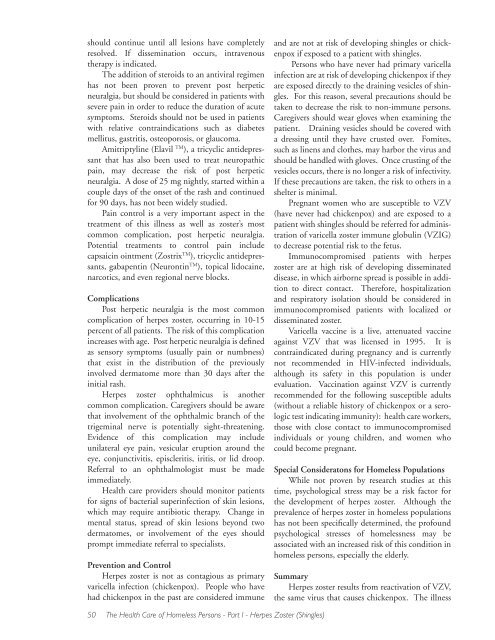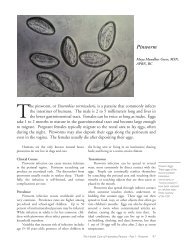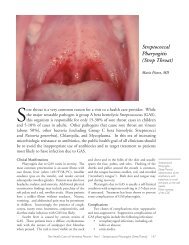Herpes Zoster (Shingles) - Boston Health Care for the Homeless
Herpes Zoster (Shingles) - Boston Health Care for the Homeless
Herpes Zoster (Shingles) - Boston Health Care for the Homeless
Create successful ePaper yourself
Turn your PDF publications into a flip-book with our unique Google optimized e-Paper software.
should continue until all lesions have completely<br />
resolved. If dissemination occurs, intravenous<br />
<strong>the</strong>rapy is indicated.<br />
The addition of steroids to an antiviral regimen<br />
has not been proven to prevent post herpetic<br />
neuralgia, but should be considered in patients with<br />
severe pain in order to reduce <strong>the</strong> duration of acute<br />
symptoms. Steroids should not be used in patients<br />
with relative contraindications such as diabetes<br />
mellitus, gastritis, osteoporosis, or glaucoma.<br />
Amitriptyline (Elavil TM ), a tricyclic antidepressant<br />
that has also been used to treat neuropathic<br />
pain, may decrease <strong>the</strong> risk of post herpetic<br />
neuralgia. A dose of 25 mg nightly, started within a<br />
couple days of <strong>the</strong> onset of <strong>the</strong> rash and continued<br />
<strong>for</strong> 90 days, has not been widely studied.<br />
Pain control is a very important aspect in <strong>the</strong><br />
treatment of this illness as well as zoster’s most<br />
common complication, post herpetic neuralgia.<br />
Potential treatments to control pain include<br />
capsaicin ointment (Zostrix TM ), tricyclic antidepressants,<br />
gabapentin (Neurontin TM ), topical lidocaine,<br />
narcotics, and even regional nerve blocks.<br />
Complications<br />
Post herpetic neuralgia is <strong>the</strong> most common<br />
complication of herpes zoster, occurring in 10-15<br />
percent of all patients. The risk of this complication<br />
increases with age. Post herpetic neuralgia is defined<br />
as sensory symptoms (usually pain or numbness)<br />
that exist in <strong>the</strong> distribution of <strong>the</strong> previously<br />
involved dermatome more than 30 days after <strong>the</strong><br />
initial rash.<br />
<strong>Herpes</strong> zoster ophthalmicus is ano<strong>the</strong>r<br />
common complication. <strong>Care</strong>givers should be aware<br />
that involvement of <strong>the</strong> ophthalmic branch of <strong>the</strong><br />
trigeminal nerve is potentially sight-threatening.<br />
Evidence of this complication may include<br />
unilateral eye pain, vesicular eruption around <strong>the</strong><br />
eye, conjunctivitis, episcleritis, iritis, or lid droop.<br />
Referral to an ophthalmologist must be made<br />
immediately.<br />
<strong>Health</strong> care providers should monitor patients<br />
<strong>for</strong> signs of bacterial superinfection of skin lesions,<br />
which may require antibiotic <strong>the</strong>rapy. Change in<br />
mental status, spread of skin lesions beyond two<br />
dermatomes, or involvement of <strong>the</strong> eyes should<br />
prompt immediate referral to specialists.<br />
Prevention and Control<br />
<strong>Herpes</strong> zoster is not as contagious as primary<br />
varicella infection (chickenpox). People who have<br />
had chickenpox in <strong>the</strong> past are considered immune<br />
and are not at risk of developing shingles or chickenpox<br />
if exposed to a patient with shingles.<br />
Persons who have never had primary varicella<br />
infection are at risk of developing chickenpox if <strong>the</strong>y<br />
are exposed directly to <strong>the</strong> draining vesicles of shingles.<br />
For this reason, several precautions should be<br />
taken to decrease <strong>the</strong> risk to non-immune persons.<br />
<strong>Care</strong>givers should wear gloves when examining <strong>the</strong><br />
patient. Draining vesicles should be covered with<br />
a dressing until <strong>the</strong>y have crusted over. Fomites,<br />
such as linens and clo<strong>the</strong>s, may harbor <strong>the</strong> virus and<br />
should be handled with gloves. Once crusting of <strong>the</strong><br />
vesicles occurs, <strong>the</strong>re is no longer a risk of infectivity.<br />
If <strong>the</strong>se precautions are taken, <strong>the</strong> risk to o<strong>the</strong>rs in a<br />
shelter is minimal.<br />
Pregnant women who are susceptible to VZV<br />
(have never had chickenpox) and are exposed to a<br />
patient with shingles should be referred <strong>for</strong> administration<br />
of varicella zoster immune globulin (VZIG)<br />
to decrease potential risk to <strong>the</strong> fetus.<br />
Immunocompromised patients with herpes<br />
zoster are at high risk of developing disseminated<br />
disease, in which airborne spread is possible in addition<br />
to direct contact. There<strong>for</strong>e, hospitalization<br />
and respiratory isolation should be considered in<br />
immunocompromised patients with localized or<br />
disseminated zoster.<br />
Varicella vaccine is a live, attenuated vaccine<br />
against VZV that was licensed in 1995. It is<br />
contraindicated during pregnancy and is currently<br />
not recommended in HIV-infected individuals,<br />
although its safety in this population is under<br />
evaluation. Vaccination against VZV is currently<br />
recommended <strong>for</strong> <strong>the</strong> following susceptible adults<br />
(without a reliable history of chickenpox or a serologic<br />
test indicating immunity): health care workers,<br />
those with close contact to immunocompromised<br />
individuals or young children, and women who<br />
could become pregnant.<br />
Special Consideratons <strong>for</strong> <strong>Homeless</strong> Populations<br />
While not proven by research studies at this<br />
time, psychological stress may be a risk factor <strong>for</strong><br />
<strong>the</strong> development of herpes zoster. Although <strong>the</strong><br />
prevalence of herpes zoster in homeless populations<br />
has not been specifically determined, <strong>the</strong> profound<br />
psychological stresses of homelessness may be<br />
associated with an increased risk of this condition in<br />
homeless persons, especially <strong>the</strong> elderly.<br />
Summary<br />
<strong>Herpes</strong> zoster results from reactivation of VZV,<br />
<strong>the</strong> same virus that causes chickenpox. The illness<br />
50 The <strong>Health</strong> <strong>Care</strong> of <strong>Homeless</strong> Persons - Part I - <strong>Herpes</strong> <strong>Zoster</strong> (<strong>Shingles</strong>)







